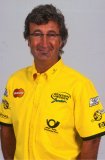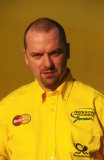Team Principals
 Chief Executive - Eddie Jordan
Chief Executive - Eddie Jordan
From modest beginnings as a mid-field racing driver in the 1970s Eddie Jordan has, in the space of 20 years, become one of Formula One's biggest players. In what has become a big business sport, dominated by blue chip corporations and motor manufactures, Eddie Jordan is the only entrepreneur to have successfully established an F1 team and to remain its majority shareholder. His charisma, energy and love of life have driven his team, Jordan Grand Prix, into the top three in the World Championship for Constructors.
Jordan began his career as a banker, making the switch to motor racing after experiencing the thrill of karting during a summer spent in Jersey. After progressing through various motor sport categories (see Career Highlights), winning several races and championships, he made his second career switch, this time from driver to team owner. "I was married with one child and another on the way, and we had no money", explains Jordan. "It would have been selfish to continue." And so, in 1980, Eddie Jordan Racing was born.
As Team Owner, Jordan could sell, he could charm, and he knew how to make a race team work; all the necessary ingredients which were to give him almost immediate success. After ten years in the lower formulae, he entered the jewel in motor racing's crown - Formula One - with the creation of Jordan Grand Prix in 1991. The team finished its debut year in an impressive fifth place in the World Championship and brought to the sport an energy and vibrance previously unknown. Nine years on, Jordan Grand Prix boasts a string of victories and membership of the Formula One elite.
Jordan is a key player on the F1 field, negotiating contracts with major sponsors and breaking new ground by securing investment from global equity investor, Warburg, Pincus (Jordan Grand Prix was the first F1 team to gain investment from a financial institution). Alongside the business image, however, Jordan retains his sense of fun. Who else would play drums at an impromptu rock concert or phone home as soon as a race is finished to find out the football scores. "I have been accused of not being a serious operator," says Jordan, "and that used to hurt. But I know what we have achieved and when I look at Jordan's history, from our victories in Formula Ford, F3 and F3000, to our impressive results in F1, I feel very proud. I hope to be able to look back on 1999 as being the season which really gave us the break to move up and become World Champions. I, and the team around me, believe in what we are doing. The question is, how far can we go? I believe we can go all the way."
 Technical Director - Mike Gascoyne
Technical Director - Mike Gascoyne
A chance look through an engineering magazine gave Mike Gascoyne his break into Formula One. "I was working at Westlands Systems to earn some money whilst writing my thesis for my PhD," explains Gascoyne, "I was reading Flight Magazine one lunch time when I saw an ad for an aerodynamicist at McLaren. I applied more for the hell of it than anything else and was offered the job. Needless to say, my thesis was never finished. If I ever tire of F1, I suppose I could always go back!"
Gascoyne is not short of qualifications to class him at the top of his field. A Cambridge graduate from one of the university's most academic colleges, Churchill, he has progressed quickly in the world of Formula One. Aged 36 he joined Jordan Grand Prix in July 1998 as Chief Designer and was promoted to Technical Director in January 1999. The success of the Jordan Mugen-Honda 199, the first car to be designed under Gascoyne's leadership, won him the 1999 Autocar award for achievement to motor sport.
Gascoyne's rapid development, he readily admits, was helped greatly by Harvey Postlethwaite, with whom Gascoyne worked for seven years. "Yes, you could call him my mentor," says Gascoyne. "It was Harvey who allowed me to learn about the overall design of a Formula One car. I trained as an aerodynamicist but always wanted to look at the bigger picture. Harvey showed me the broad overview of Formula One engineering, and working under him for five years at Tyrrell gave me invaluable experience. His passing was a great loss to motor sport engineering."
Gascoyne defines his role at Jordan very clearly. "My job is to take the team to the level where we can win races from the front and therefore win World Championships." His aim is to ensure Jordan has the right technical programmes to design and build a competitive car to keep the team in the top echelons of the sport. "We have restructured our working practices in the drawing office and wind tunnel to enable the expertise and resources to be used much more efficiently. We have worked on optimising our design team's performance and on putting in place the right provisions for the future."
He is equally clear about his design philosophy. Delegation, management and motivation are crucial, as is ensuring that responsibility is being given to the right people. "I don't care if not a single one of my ideas ends up on the car," explains Gascoyne, "if this means someone else has had a better idea. If my ideas spark off other peoples' ideas and we end up with a better car, I feel I have succeeded. Ultimately I make the decisions, but before doing so I want to have everyone's input in order to choose the right solution to give us the best car. I would not pretend there is anything new in this, but perhaps it is something new to Jordan."
To escape the world of F1, Gascoyne enjoys DIY, making furniture and watching sport. Living on a farm with his wife and two children does allow him some retreat. But his competitive nature and passion for team work makes Formula One the perfect vehicle upon which he can combine engineering with his favourite sport.
Managing Director - Trevor Foster
Appointed joint managing director of Jordan Grand Prix in 1998, Trevor Foster, 47, has played a key role in the team's success. As team manager of Eddie Jordan Racing in the 1980s he was responsible for guiding the team to victory in the 1987 British Formula 3 Championship and 1989 FIA Formula 3000 series, before taking the team into Formula One under the new name of Jordan Grand Prix in 1991.
Foster's career spans 30 years, having previously worked with other F1 teams including Tyrrell and Team Lotus. He has also run teams in Formula 3 and Formula Ford 2000, though Formula One dominates his CV.
Following Jordan's acquisition of Benson and Hedges' sponsorship in 1996, it was Foster who masterminded the development of the team, putting resources into new areas of technology and research and development. He is responsible for the day to day management of Jordan Grand Prix in terms of all Formula One team operations and, together with Eddie Jordan, Commercial Director Ian Phillips and Financial Controller Richard O'Driscoll, forms the senior management team of the company.
A keen follower of all forms of motor racing, Foster has sharp eye for up-and-coming talent, having worked with Eddie Jordan to give drivers such as Michael and Ralf Schumacher, Johnny Herbert, Jean Alesi, Martin Donnelly, Heinz-Harald Frentzen and Eddie Irvine their break into Formula One.
During Grand Prix weekends Foster joins the race engineering team in developing strategy and technical direction for the race.
The Drivers
Click on the thumbnail to view the image in full size

